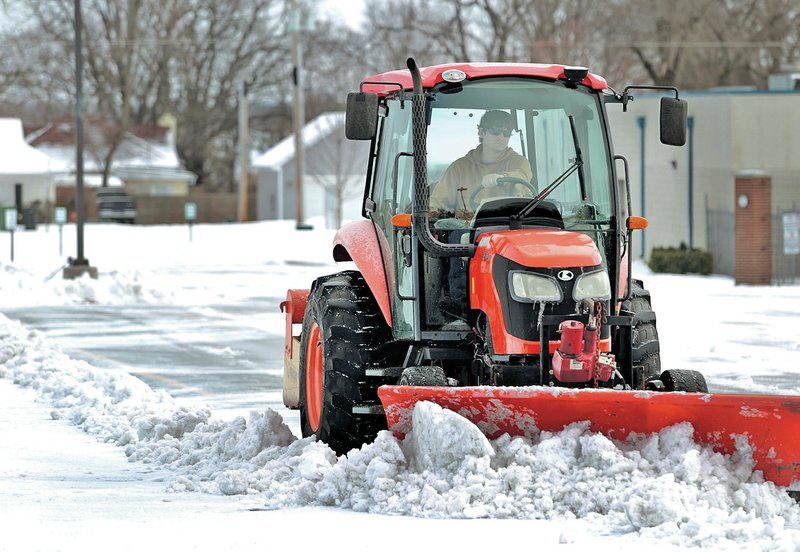The National Weather Service confirmed what many suspected: This is one of the coldest winters on record.
The average temperature from December through February, taken from 180 daily highs and lows, was 1 degree above freezing in Fayetteville and at Northwest Arkansas Regional Airport. That's slightly more than 4 degrees below normal, or the fifth coldest winter since 1949, when recordkeeping began.
By The Numbers (w/logo)
Temperatures
Average temperatures (day and night) at Fayetteville’s Drake Field:
w December: 34.4 degrees, 3.1 below average
w January: 31.5 degrees, 4.1 below normal
w February: 33.8 degrees, 5.9 below normal
w Winter (weighted): 33.2 degrees, 4.3 below normal
Source: National Weather Service
"While it's not earth-shattering or anything like that, it did favor on the colder side of what we would typically expect," Joe Sellers, meteorologist with the weather service's Tulsa, Okla., office, said last week.
Sellers said this season has been a wakeup call after two unusually warm winters, a sentiment echoed by Mike Borengasser, state climatologist with the Arkansas Natural Resources Commission.
"We've had really mild winters, so I guess we got spoiled to thinking it's normal. This is winter," Borengasser said with a laugh.
Three storms dropped 14 inches of snow and ice, not counting the 3 inches or so that fell March 2, with temperatures bottoming out at minus 3 degrees in January and February, according to the weather service.
Despite the overall cold, area temperatures also swerved from deep freeze to T-shirt weather.
February, which had about 5 inches of snow, also had almost two weeks straight of highs above 50 degrees and four days of highs near 70. Daily highs jumped or dropped 30 degrees in three days or less a dozen times since early December.
"It really plays havoc with my business," said Steve Johnson, owner of Bentonville's Mermaid Car Care, a car detail shop. Far from being a boon for car cleaners, he said, the topsy-turvy weather instead drove people away.
"You get your car washed today and you drive home, and in the garage tonight it looks terrible," he said. "This (winter) seems like it has lasted longer than most of them."
Average highs for the winter range from the mid-40s to lower 50s.
"In the end it all evens out," Sellers said. "Very rarely is it average; 99 percent of the time it's one side or the other."
Fewer Bugs?
Luckily for the trees, the abrupt warm episodes likely occurred too early to coax them out of hibernation only to be struck by a freeze.
"Most of these things have gone dormant, and it hasn't been warm enough, long enough for them to come out of their dormancy," said Ralph Henry, a plant physiology professor at the University of Arkansas. "They also use light as a cue to when to come out of dormancy, not just temperature."
The most recent cold snap at the beginning of March was lucky, Henry said.
"If this had happened two weeks later, I think you'd see more potential for damage," he said. "End of February, beginning of March: not so bad. End of March: lots of damage."
It's a different story for ticks, ants and other pests, said Kelly Loftin, associate entomology professor at the University of Arkansas.
"It's hard to make a lot of predictions, I'll say that," he said. "The short answer is it's going to depend a lot on which insect you're talking about. For most of them, what we may see will be a delayed start."
Lone star ticks, for example, become active as early as January in mild years but may be quiet until this April, Loftin said. Some mosquitoes also might get a late start.
Up to 80 percent of non-native bugs such as fire ants could be wiped out, Loftin added, but native pests such as the ticks will come back eventually.
What's Next?
The average U.S. temperature this winter was slightly below normal, but the country was strongly lopsided between extremes, with Arkansas roughly in the middle.
In the West, particularly California, temperatures were abnormally high, while the East was unusually cool, according to the National Climatic Data Center, which is affiliated with the weather service.
Still, Sellers said there's no guarantee the next few months will be as bumpy.
"Temperature-wise it doesn't look like the long-term trends are going to favor colder or warmer," he said, referring to outlooks for the next four months. "There's kind of equal chances. Nothing stands out as a clear signal one way or the other."
Borengasser, the state climatologist, wasn't as sure.
Climate change caused by carbon pollution could be making swerves in weather more common, he said. While the U.S. has been fairly cool, December and January were among the warmest globally in more than 130 years of records, according to the data center. Climate scientists agree more heat can power more erratic temperatures and rainfall.
"It seems the heat has driven the engine to more extreme weather," Borengasser said.
NW News on 03/09/2014

